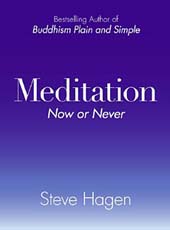"Meditation begins now, right here. It can't begin someplace else or at some other time," writes Steve Hagen, author of Buddhism Is Not What You Think. He received his Dharma transmission from Zen master Dainin Katagiri Roshi in 1989 and is now head teacher at Dharma Field Meditation and Learning Center in Minneapolis.
In a very cogent chapter, Hagen explicates the things mistaken for meditation — relaxation, visualization, acquiring supernatural powers, a bodily form of philosophical inquiry, a means of achieving enlightenment, a way of escaping our lives, or a pathway to bliss or ecstasy. He shares a teaching story:
"Bankei was in the middle of his lecture when the priest arrived. The priest made such a racket that Bankei stopped his lecture and asked the priest about the noise.
" 'The founder of our sect,' boasted the visiting priest in response, 'had such miraculous powers that he could hold a brush on one side of the river, while his attendant held a piece of paper on the other side, and the teacher could write his name through the air. Can you do something like this?'"Bankei replied calmly, 'Perhaps your teacher can perform such a trick, but that's not the manner of Zen. My miracle is that when I'm hungry I eat, and when I'm thirsty I drink.' "
Hagen lays out the practice of formal sitting meditation and then moves on to walking meditation. He also describes some of the problems people experience after taking up these practices. "Meditation is doing one thing and doing it completely," he says. Putting ourselves into what we are doing is an important part of meditation. This means being present and awake. Another term for this is wholeheartedness.
Hagen believes that constancy is the single most important factor in sustaining a meditation practice. Both determination and discipline are required. But these are qualities that are under-valued in our society where busyness and distraction are the name of the game. The thrust of this paperback is not to present ideas about meditation but to show how to take it up and to do it, thus making it not a technique but a way of life. Hagen also has some important things to say about silence, sitting with others, slowing down, and meditation without doing.
